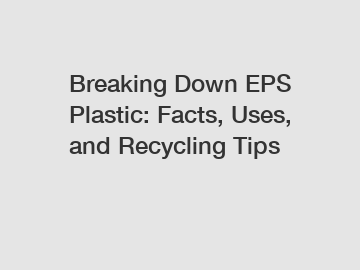Breaking Down EPS Plastic: Facts, Uses, and Recycling Tips
Are you familiar with EPS plastic? Also known as expanded polystyrene, EPS is a versatile and lightweight plastic material that is used in a variety of products. From packaging materials to insulation panels, EPS plastic plays a key role in our daily lives. In this blog post, we will break down EPS plastic, discussing its facts, uses, and recycling tips.
Facts About EPS Plastic:
EPS plastic is a type of thermoplastic material that is derived from the polymerization of styrene monomer. It is manufactured through a process that involves expanding polystyrene beads with steam, resulting in a lightweight and rigid material with excellent insulation properties.

EPS plastic is commonly used in packaging materials such as foam trays, cups, and containers. It is also used in the construction industry for insulation panels, concrete forms, and lightweight fillers.
One of the key characteristics of EPS plastic is its ability to absorb shock and impact, making it an ideal material for packaging fragile items. Its lightweight nature also makes it cost-effective to transport and recycle.
Uses of EPS Plastic:
EPS plastic has a wide range of uses across various industries. In the packaging industry, EPS foam trays are commonly used to package fresh produce, meat, and seafood. EPS cups and containers are also used for takeaway food and drinks due to their lightweight and insulating properties.
In the construction industry, EPS insulation panels are widely used to improve the energy efficiency of buildings. EPS concrete forms are used to create lightweight and durable structures, while EPS lightweight fillers are used to reduce the weight of concrete without compromising its strength.
Other common uses of EPS plastic include protective packaging for electronics, appliances, and pharmaceutical products. EPS coolers are also used for transporting perishable goods such as vaccines and medications.
Recycling Tips for EPS Plastic:
While EPS plastic is a versatile and useful material, it is also important to consider the environmental impact of its disposal. EPS plastic is not biodegradable and can take up valuable space in landfills if not properly recycled.
One of the most effective ways to recycle EPS plastic is through a process known as mechanical recycling. In this process, EPS foam trays and packaging materials are collected, cleaned, and shredded into small pieces. These pieces are then melted down and formed into new products such as picture frames, crown molding, and surfboards.
Another method of recycling EPS plastic is through a process called pyrolysis, where the material is heated in the absence of oxygen to break it down into its chemical components. The resulting gases can be used as fuel, while the remaining solid material can be used to create new products.
In addition to recycling, it is also important to reduce the amount of EPS plastic waste generated by using alternative packaging materials such as paper, cardboard, or biodegradable plastics. By choosing eco-friendly options and supporting companies that prioritize sustainability, we can all play a part in reducing the environmental impact of EPS plastic.
In conclusion, EPS plastic is a versatile and useful material that has a wide range of applications in various industries. By understanding the facts, uses, and recycling tips for EPS plastic, we can all make more informed decisions about its use and disposal. Let's work together to promote a more sustainable future for our planet.
Contact us to discuss your requirements of How much does the lost foam casting equipment, Continuous EPS pre-expander machines, Sand temperature regulator. Our experienced sales team can help you identify the options that best suit your needs.

Comments
0